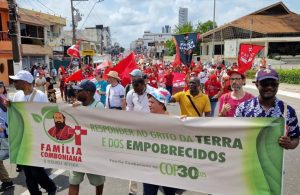Every town and city has its own tales, myths, and legends that make up part of the culture of Nicaraguans.
León is the second largest city in Nicaragua, after Managua. It was founded by the Spanish as Santiago de los Caballeros de León. The city is located along the Río Chiquito (Chiquito River), 90 kilometres northwest of Managua, and 18 kilometres east of the Pacific Ocean coast. Among the museums there is a Museo de Leyendas y Tradiciones (Museum of Traditions and Legends), which tells the stories of the city.
One of the interesting legends in León is the Carreta Nagua. A bewitched wooden cart comes out at night drawn by two emaciated oxen, their hides tight over their rib cages, guided by death himself, skeletal in appearance. Others say there are two skeletons, each with a wide hood and a candle in hand, leading the beasts along the streets. The wooden wheels make a tremendous creaking sound, so frightful that no neighbour dares go near their window to look out.
The legend of the Carreta Nagua is an expression of the terror that reigned during the conquest, an indelible footprint of panic in the collective memory of the indigenous peoples. Spanish soldiers raided villages at night because it was difficult to capture them during the day when they were out in the hills and fields.
The conquistadores (conquerors) generally went around with a caravan of oxcarts to round people up to labour as slaves in the silver mines of Peru. The captured people were chained to the posts on the carts. The noise made by the wooden wheels were horrifying to the indigenous people, who hadn’t heard it until they encountered the Spanish. They interpreted the sound as a fresh manifestation of the nocturnal spirits that constantly laid siege to the peaceful calm of their villages.
Some of the elders assert that the cart is announcing a recent death. As it rolls down the deserted streets, the howls of dogs can be heard in the distance. Those who say they did catch a glimpse of the Carreta Nagua tell of how they came down with a tremendous fever or fainted. Others are said to have died of fright at this hair-raising spectre.
*
Among other Nicaraguan figures famed in León’s culture is a large hound with brilliant eyes that makes a distinctive sound as it goes down the street, its claws scraping the ground. The name of this creature is a cadejo, and there is a good one and an evil one. The evil cadejo kills those it finds in its way under the cover of the night’s darkness. Many León residents have laid testimony to having seen someone die as a result of an encounter with a cadejo.
*
The town of Masaya is just east of the Masaya Volcano, an active volcano from which the city takes its name. It is Nicaragua’s third most populous city, and it is culturally known as the City of Flowers. Masaya is known as ‘The Cradle of Nicaraguan Folklore.’ The neighbourhood Monimo in Masaya is one of the most important indigenous villages located in the pacific region of Nicaragua. Monimbo is a Nahuatl word which means ‘close to the water’: Monimbo takes its name due to its proximity of Lake Masaya. Monimbo is making a massive effort to preserve indigenous legacies.
A popular tale is about La Cegua, as told in Monimbo. The legend has to do with women who by night disguise themselves as ghosts with painted faces and long tresses of hair. They go out very late at night in search of unfaithful men who have cheated on their wives, misled lovers, or men and women with rivalries because of jealousy over some amorous or passionate relationship.
Elders said that someone who runs across them and hears their insufferable shrieking becomes despairing, gets nervous, and fall to the ground ill or unconscious. At precisely that moment, La Cegua bewitches or puts a spell on their victim. They vomit out their souls and transform themselves into young women garbed in leaves of garuma. Their hair reaches down to their waist and is made of cabuya (sisal), and their teeth are caked with green like the peel of a green plantain.
As children, many of us that have now grown up heard this story about women of the night that toyed with men they found along the way, mainly those unfaithful men who are deserving of punishment and those who stay out too late. From this comes the phrase ‘you are playing La Cegua’, said to those who behave in a silly or foolish manner.
*
The town of La Trinidad is reportedly the source for one the most well-known mythological figures, La Mocuana. Josefa Maria Montenegro in her book Nicaraguan Legends has one version of this tale: “Around 1530, the Spaniards carried out a well-armed expedition into Nicaraguan territory in order to extend their domain and increase their wealth… The chief of the tribe, once vanquished, presented the conquistadores with deerskin pouches filled with nuggets of gold.
The news in Spain of the conquistadores having returned with great wealth drew the attention of a young man who aspired to be a man of the cloth and whose father had died during the incursion. His mind made up, the young man joined a new expedition and after a long and arduous journey arrived on Nicaraguan soil, where he was well received by the residents who thought he was a priest.
On arriving in Sebaco, the young man met the beautiful daughter of the cacique and romanced her with intentions of seizing the wealth of her father. The young woman fell in love with the Spaniard and as proof of her love, let him know where her father kept his riches. There are those who say that the Spaniard also fell in love with her.
The cacique (leader of the tribe), on hearing about the affair between his daughter and the foreigner, made his opposition to the relationship clear and they had to run away. But the cacique tracked them down and faced off against the Spaniard, killing him. Then he locked up his pregnant daughter in a cave in the hills. Other versions have it that the Spaniard locked up his lover after seizing the treasures.
The legend tells of how La Mocuana went crazy being locked up and later managed to get out through a tunnel, but in doing so she dropped her baby son into an abyss. Ever since, she appears on the road inviting those passing by to her cave. Those that have met her say they never saw her face, only her svelte figure and long beautiful black hair.
*
There are many other tales left to tell in which the history of our ancestors is an interplay between reality and fiction, the visible and the hidden, the mysterious and the day-to-day. The comings and goings of other cultures that clash with the rooted beliefs of our forebears have made us into a people that uses its myths and legends to defend and express our own culture.
(Pedro Santacruz)






